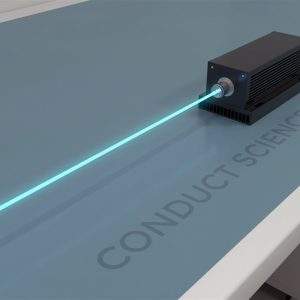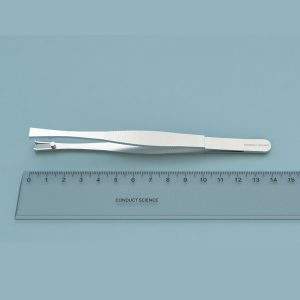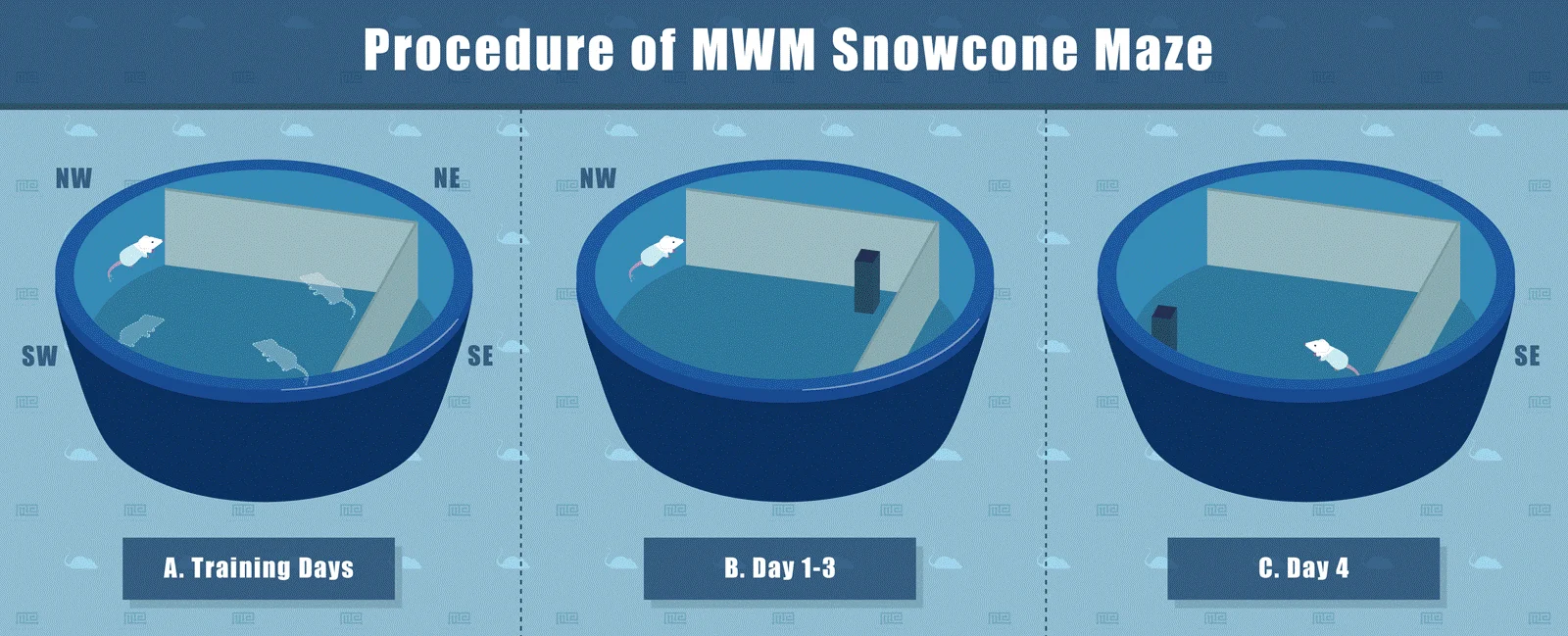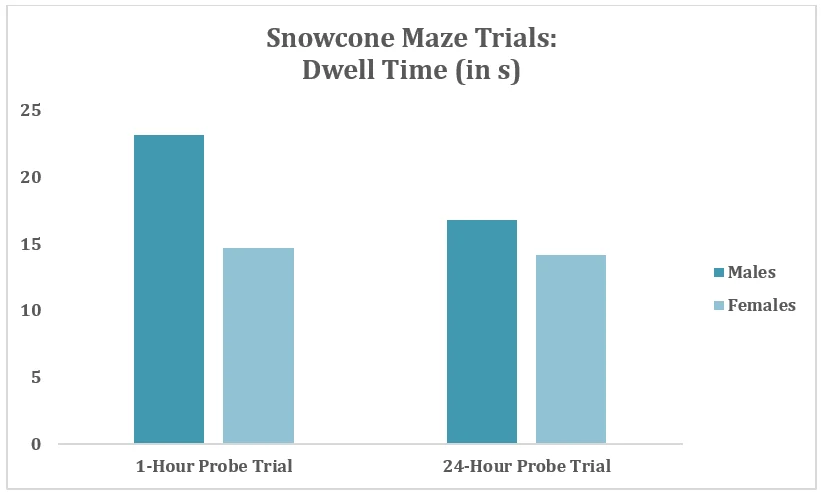The MazeEngineers Snowcone Morris Water Maze modification utilizes the MWM as a base. It comes with two stainless steel inserts to fit the Morris Water Maze of your choice.
Typically, the tub can be filled with 0.3m (11 inches) of water. These accessory inserts create a snow cone shape in the Morris Water Maze. This square corner formed by the inserts acts as a geometric cue
A square (10 x 10 cm) black Pexiglas platform is provided. It is typically placed 25 cm from the pool edge.
Researchers often place an opaque coloured balloon measuring roughly 20 cm
in diameter was hung 15 cm above the platform. This is not included

MazeEngineers empowers preclinical neuroscience research with meticulously designed, customizable behavioral apparatuses. From manual classic mazes to fully automated smart systems, we provide the tools scientists need to capture high-quality, reproducible data for studies on learning, memory, anxiety, and depression.

bool(false)


bool(false)

The Snowcone Maze presents a novel adaptation of the classic Morris water task (Morris, 1984), tailored for the examination of spatial learning and memory in rodents. By incorporating an angular shape as a geometric reference point (Keeley et al., 2013), this innovative design facilitates a more nuanced exploration and evaluation of spatial navigation strategies in rodents.
Distinctly, the Snowcone Maze integrates two types of spatial cues. The geometric cue is manifested through the tub’s single right-angled corner, shaping the overall snowcone-like structure, while the landmark cue takes the form of an opaque colored balloon positioned above or near the escape platform’s location. This task is strategically crafted to discern and differentiate preferences in cue-based navigation by presenting rodents with two distinct sources of information, thus determining which cue type they favor.
The apparatus boasts diverse applications in investigating sex differences in cue strategies among rodents. Research endeavors of this nature have contributed significantly to advancing our understanding of spatial strategies and elucidating the connections between brain anatomy and behavior, particularly through comparative analyses of fundamental differences in brain anatomy between male and female rodents, such as hippocampal subregion densities (Keeley et al., 2013).
The Snowcone Maze configuration utilizes the Morris water maze tank as its foundation, incorporating stainless steel inserts to introduce square corners along the pool border. This modification, with a 90-degree corner inserted into one quadrant, forms the distinctive snowcone shape of the apparatus.
Typically filled to a depth of 0.3 meters with opaque water, the tank features a square black plexiglass escape platform positioned within one of the four quadrants during pretraining, its surface visible 1 centimeter above the water level. In addition to the geometric cue provided by the snowcone maze’s shape, an opaque colored balloon, measuring 20 centimeters in diameter, can serve as a landmark cue, positioned directly above the escape platform’s location. The presentation of these two spatial cues represents a pivotal aspect of the snowcone maze, offering rodents distinct options for navigation.
Pre-training Protocol
In preparation for the snowcone maze task, rodents undergo a structured pre-training regimen, initially familiarizing themselves with the general Morris water maze (MWM) procedures and subsequently acquainting themselves with the two spatial cues incorporated into the setup. During the initial training phase spanning the first three days, the escape platform is situated in the quadrant featuring the 90-degree corner, with the balloon landmark positioned directly above it. Throughout these trials, rodents learn to associate both the geometric cue (corner) and the landmark cue (balloon) with the escape platform’s location.
Rodents are released into the water and granted 120 seconds to locate the escape platform. In instances where rodents fail to succeed, researchers intervene to guide them to the platform. Once the rodent reaches the platform, it remains there for a total of 15 seconds. Each training day consists of five trials.
Transitioning to the second phase of training on the fourth day, the escape platform and landmark balloon are relocated to the quadrant opposite their initial position in the corner. This strategic adjustment aims to reinforce the rodent’s utilization of both the landmark cue and the geometric cue throughout maze navigation. Throughout all training trials, latency (time taken to reach the platform) and path length are meticulously recorded using a timer and advanced video-tracking technology like Noldus Ethovision XT.
Probe Trial Procedure
During probe trials, both the escape platform and the landmark cue are removed from the maze. Rodents are introduced into the tank and allowed 120 seconds to locate the absent escape platform. This procedure enables researchers to gauge the relative salience of each cue to the rodent’s navigation strategy. Additional variables, including the percentage of time spent in the quadrant with the 90-degree angle and the rodent’s heading angle, are measured to provide further insights. Similar to training trials, latency and path length are recorded using a timer and Noldus Ethovision XT throughout all probe trials.

Aplicaciones
Una aplicación significativa del laberinto de cono de nieve es discernir las diferencias de género en las estrategias de navegación espacial entre roedores (Rodríguez et al., 2010; Keeley et al., 2013). Los estudios sobre las diferencias de género en el comportamiento espacial permiten comparaciones de diferencias fundamentales en la anatomía y bioquímica del cerebro, como las densidades de subregiones del hipocampo y los niveles de estradiol (Keeley et al., 2013); conocimiento que puede guiar descubrimientos en estudios de navegación espacial en humanos.
The sample data is depicted through plotting the mean dwell time of rodents in the geometric cue quadrant, distinguishing between males and females. The graphical representation illustrates a notable difference: male rodents consistently spend a significantly longer duration in the geometric cue quadrant compared to female rodents during both probe trials. This observation suggests a pronounced bias among male rodents towards the geometric environmental cue. Conversely, female rodents display a preference for the alternative environmental cue provided, specifically the landmark balloon.

Advantages
The straightforward design of the Morris water task seamlessly integrates with the unique configuration of the snowcone maze, creating a tool that effectively delineates various spatial information sources. Specifically, the snowcone maze enables exploration of diverse strategies for solving a simple spatial task, highlighting the utilization of distinct environmental cues—both the geometric layout of the tank and the landmark cue.
By juxtaposing these two environmental cues in opposing directions, discernible preferential disparities can be observed.
Limitations
Navigating the snowcone maze to locate the escape platform entails extensive training procedures for rodents, akin to other Morris water maze (MWM) experiments. Nevertheless, this challenge can be mitigated through the implementation of a straight swim channel.
Morris, R. (1984). Developments of a water-maze procedure for studying spatial learning in the rat. Journal of neuroscience methods, 11(1), 47-60.
Rodríguez, C. A., Torres, A., Mackintosh, N. J., & Chamizo, V. D. (2010). Sex differences in the strategies used by rats to solve a navigation task. Journal of Experimental Psychology: Animal Behavior Processes, 36(3), 395.
Keeley, R. J., Tyndall, A. V., Scott, G. A., & Saucier, D. M. (2013). Sex difference in cue strategy in a modified version of the Morris water task: correlations between brain and behaviour. PloS one, 8(7), e69727.
There are no questions yet. Be the first to ask a question about this product.